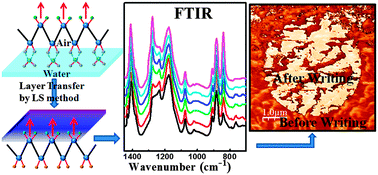Self-oriented β-crystalline phase in the polyvinylidene fluoride ferroelectric and piezo-sensitive ultrathin Langmuir–Schaefer film
Abstract
We report on the direct observation of ferroelectric switching and piezoelectric behaviour in ultrathin polyvinylidene fluoride (PVDF) films prepared by horizontal Langmuir–Schaefer (LS) technique. We have prepared pure β-phase by just increasing the number of LS layers without using additional non-ferroelectric assisting agents. Edge-on oriented CH2–CF2 units of PVDF at the air–water interface enable self-orientation of ferroelectric dipoles by means of the hydrogen bonding network. Such restricted conformation of PVDF at the air–water interface results in an increased net dipole moment with the number of LS layers. The film's ferroelectric switching and piezoelectric sensitivity are demonstrated by hysteretic polarization switching loops and butterfly-loops, respectively. Successful circular domain writing on ultrathin LS film, down to 5 monolayers of PVDF, is demonstrated. The achievement of pure β-phase of PVDF at room temperature without using any assisting agents may be promising for non-volatile memory and piezoelectric-based, ultrathin smart sensor devices.


 Please wait while we load your content...
Please wait while we load your content...